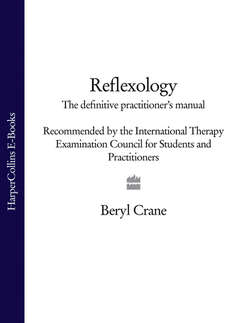Читать книгу Reflexology: The Definitive Practitioner's Manual: Recommended by the International Therapy Examination Council for Students and Practitoners - Beryl Crane - Страница 35
The Spleen meridian
ОглавлениеThe Spleen meridian (figure 2.14) is a Yin channel with 21 points. It commences on the medial edge of the base of the nail bed of the great toe and ascends the leg on the medial side to enter the abdomen; there it communicates with the Conception Vessel (see figure 7.6) where it connects with its relevant organ, the spleen. From here it connects with some of the internal organs, the stomach – its paired organ, liver and gall bladder. The meridian continues up through to the diaphragm, one offshoot going directly to the heart and the other ascending into the throat and root of the tongue.
The nerve line is along the cutaneous medial dorsal nerves of the foot and plantar nerves, then along the saphenous, tibial and femoral nerves, which arise from L2-L4 of the spinal trunk; there it connects with the thoracic nerves, then it continues on up to the intercostal nerves and pectoral nerves.
Figure 2.14 The Spleen/Pancreas meridian
Figure 2.15 This tongue pressor was used on the posterior wall of the pharynx to give relief during menstruation. (Fitzgerald made a statement to the effect that while he had not heard of any miscarriages he cautioned its use in pregnancy.)
Disorders of this meridian, with signs and symptoms, include: anything concerned with the brain and central nervous system; spinal problems; all genitourinary problems; abdominal and intestinal disorders, such as flatulence, any abdominal pain, gastric pain, painful haemorrhoids, diarrhoea, constipation, irregular menstruation.
As a speculative comment, SP-3 is used for all lung problems. This point is on the lung area in reflexology. SP-4 is a point that is widely used for all excess problems of the stomach and the spleen; this area corresponds to the upper abdominal area in reflexology. Also the Spleen meridian ends in the root of the tongue; Fitzgerald use to apply a tongue pressor (figure 2.15) to reach as far back as possible on the root of the tongue for amenorrhoea, also for painful menstruation. This point is a good point to regulate menstruation, and the former helps in strengthening the spine.
